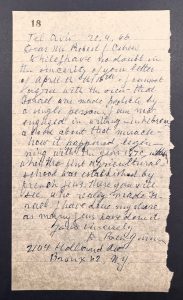Raphael Tuck was born in Poland in 1821, where he became an accomplished Talmud scholar. He moved to England with his wife and seven children and in 1866 opened Raphael Tuck & Sons as a distributor of pictures and frames, a business that soon expanded to graphic art printing.
Ironically, he is best remembered as the chief promoter of the Christmas card, launching nationwide design contests that received thousands of entries. The company began printing postcards starting in 1899, and by 1904 it had 15,000 designs in production issued in different series.
One of those series was called “The Wide-Wide-World” which included 12 illustrations of the Holy Land by John Fulleylove, who visited Palestine in 1901. The series featured this postcard of The Fields of Ruth and Boaz which includes this description:
“[It is] near Bethlehem, the City of David, looking across a pleasant landscape to the dim blue mountains of Moab. We remember the idyllic story of Ruth and Naomi, and think how Ruth must have often have gazed across these very fields, when the reapers of Boaz were working in them, to her distant home in the mountains. Here too, King David played in boyhood, and for the water of its well he longed in the day of his adversity.”
The story of Ruth is read on Shavuot which begins at sundown on June 1. Ruth’s conversion to Judaism is thought to be analogous to the Jewish people’s acceptance of the Torah, which is celebrated on this holiday. Ruth is also the great-grandmother of King David.
Raphael Tuck had a descendant who was no slouch either. His grandson, Desmond, was running the company with his brother, Sir Reginald, when its facility was bombed by the Nazis in 1940. The company quickly was back in business and worked with Britain’s Intelligence Agency M19 to supply “escape and evasion materials.”
It is thought that this was a special, extremely thin paper concealed between two layers of paper that were used for letters sent to Allied prisoners of war. When the letter was soaked in water, the middle layer would separate and an escape map would be revealed.
The company ultimately merged with several others to become British Printing Corporation, which was acquired in 1981 by Robert Maxwell who changed the company’s name to Maxwell Communications Corporation. That company went bankrupt following Robert Maxwell’s death in 1991. Maxwell was buried in Jerusalem, not far from the fields of Ruth and Boaz pictured in this postcard.







